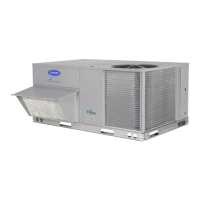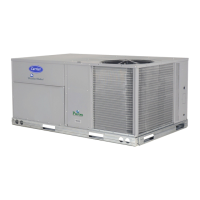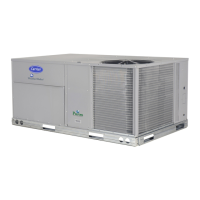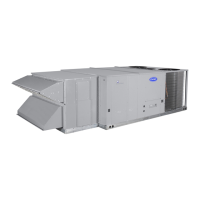37
C06153
Fig. 51 -- Burner Tray Details
6. Remove igniter wires and sensor wires at the Integ-
rated Gas Unit Controller (IGC). (See Fig. 52.)
7. Remove the two screws attac hing the burner rack to
the vestibule plate (Fig. 50).
8. Slide the burner tray out of the unit (Fig. 51).
9. Reverse the procedures outlined above to reinstall t he
burner rack.
Cleaning and Adjustment
1. Remove burner rack from unit as described in Re-
moval and Replacement of Gas Train section, above.
2. Inspect burners; if dirty, re move burners from rack.
(Mark each burner to identify its position before re-
moving from the rack.)
3. Use a soft brush to clean burners and cross--ove r port
as required.
4. Adjust spark gap. (See Fig. 53 and Fig. 54.)
5. If factory orifice has been removed, check that each
orifice is tight at its threads into the manifold pipe
and that orifice projection does not exceed maximum
valve . See Fig. 50.
6. Reinstall burners on rack in the same locations as
factory--installed. (The out side crossover flame
regions of the outermost burners are pinc hed off to
prevent excessive gas flow from the side of the burner
assembly. If the pinched crossovers are installed
betwee n two burners, the flame will not ignite
properly.)
RACEWAY
INTEGRATED GAS UNIT
CONTROLLER (IGC)
HOLE IN END PANEL (HIDDEN)
C08454
Fig. 52 -- Unit Control Box/IGC Location
7. Reinstall burner rack as describe d in Removal and
Replacement of Gas Train section, above.
Gas Valve — All three--phase models (except Low NOx)
are equipped with 2--stage gas valves. Single--phase
models and all Low NOx models are equipped with
single--stage gas valves. See Fig. 57 for locations of
adjustment screws and features on the gas valves.
To adjust gas valve pressure settings:
IMPORTANT: Leak check all gas connections including
the main service c onnection, gas valve, gas spuds, and
manifold pipe plug. All leaks must be repaired before
firing unit .
Check Unit Operation and Make Necessary
Adjustments
NOTE: Gas supply pressure at gas valve inlet must be
within specified ranges for fuel type and unit size. See
Table 9 and Table 10.
1. Remove m anifold pressure tap plug from manifold
and connect pressure ga uge or manometer. (See Fig.
51.)
2. Turn on electrica l supply.
3. Turn on unit main gas valve.
4. Set room thermostat to call for heat. If unit has two--
stage gas valve, verify high--stage heat operation be-
fore attempting to adjust manifold pressure.
5. When main burners ignite, check all fittings, mani-
fold, and orifices for leaks.
6. Adjust high--stage pressure to specified setting by
turning the plastic adjustment screw clockwise to in-
crea se pressure, counter--clockwise to decrease pre s-
sure.
7. For Two--Stage Gas Valves set room thermostat to
call for low--stage heat. Adjust low --stage pressure to
specified setting.
8. Replace regulator cover screw(s) when finished.
9. With burner access panel removed, observe unit heat-
ing operation in both high stage and low stage opera-
tion if so equipped. Observe burner flames to see if
they are blue in appearance, and that the flames are
approximately the same for each burner.
10. Turn off unit, remove pressure manomete r and re-
place the 1/8 in. pipe fitting on the gas manifold. (See
Fig. 50.)
Limit Switch
Remove blower access panel. Limit switch is located on
the fan deck. See Fig.46.
Burner Ignition
Unit is equipped with a direct spark i gnition 100% lockout
system. Integrated Gas Unit Controller (IGC) is located in
the control box. See Fig. 52. The IGC contains a
self--diagnostic LED (light --emitting diode). A single LED
(see Fig. 58) on the IGC provides a visual display of
operat ional or sequential problems when the power supply
is uninte rrupted. When a bre ak in power occurs, the IGC
will be reset (resulting in a loss of fault history) and the
indoor (evaporator) fan ON/OFF times will be reset. The
48HC

